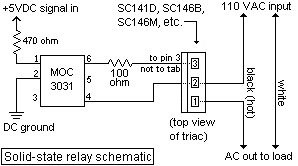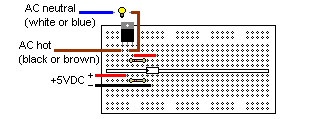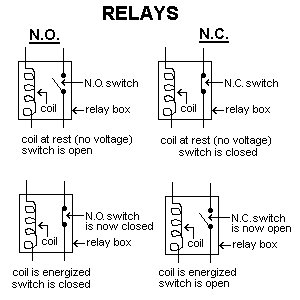| |
Switching 110VAC - Relays vs. Solid State |
|
Solid state relays do the same thing (switch 110VAC), only electronically. They still have the "control pins" (where the coil would be if it were a relay) and the input and output pins of the switch. However, there isn't a coil inside. Remember we are talking about switching 110VAC here. Because of this, one has to select the solid state switch designed to accomplish this task. One can purchase these devices from many electronic parts stores. Remember to simply check the ratings and make sure you provide yourself with a safety margin. For example, if the part will handle up to 3 amps of current, don't run 3 amps. Instead run something like half that. This way no one will get hurt because of a device failure and the device will work longer than running it at it's maximum rating.

Relays and solid state switches allow a person to use a small voltage to control a larger voltage. The following is my attempt at explaining how relays work and how they compare to solid state AC switches. Please remember that working with mains voltage (110VAC) can be dangerous. Let's be careful out there.
Standard disclaimer: I'm not responsible for anyone hooking these circuits up and the results that follow their use.
Relays
Let's start with explaining how relays work. If you are at this page you probably know how a speaker works, right? There's a coil in the back of each speaker and that coil, when voltage is applied to it, moves the speaker cone. The same is true in a relay. There is a small coil in it that, when voltage is applied to it, moves a SWITCH instead of a speaker cone. So if you get a 5 volt relay, if you apply 5 volts to the coil, the switch side of the relay gets moved and changes it's connections (i.e. on or off). If you look on the back of a relay package (one that has a picture on it of how the relay is wired), you'll notice a funny loop-to-loop line. That's the symbol for the coil. It usually has two connections (or pins) to it. The other lines show how the switch is wired. You might also see abbreviations like N.C. and N.O.. These stand for "Normally Closed" and "Normally Open." If a switch is open, that means it is NOT making a connection. If it is closed, that means it IS making a connection.
Ok, let's tie these two terms (N.C. and N.O.) to a relay:
If a switch is N.O., that means when voltage isn't applied to the coil (the coil is at rest), there is no connection (the switch is open). It is called Normally Open because the coil is at "rest" and this is the normal position for it.
So if you apply a voltage to a N.O. relay, the switch inside closes and makes a connection. Remove the voltage and the switch opens.
If a switch is N.C., that means when voltage isn't applied to the coil (the coil is at rest), there is a connection (the switch is closed). It is Normally Closed because the coil is at "rest" and this is the normal position for it.
So if you apply a voltage to a N.C. relay, the switch inside opens and breaks the connection. Remove the voltage and the switch closes.
Relays are mechanical because they have moving parts inside of them. That's why you can hear them click on and off. Because they are mechanical, they are "slow" when compared to electronic switches (i.e. solid-state switches) which have no moving parts.
While a relay can be used to switch more than just 110VAC (because it's a physical connection), one has to take care when choosing which relay to use. The switch's contacts are usually rated at a certain voltage and current carrying capacity and not staying within those specifications can result in something as simple as the device not working to fire and danger!
Solid State Switches
Solid state relays do the same thing (switch 110VAC), only electronically. They still have the "control pins" (where the coil would be if it were a relay) and the input and output pins of the switch. However, there isn't a coil inside. Remember we are talking about switching 110VAC here. Because of this, one has to select the solid state switch designed to accomplish this task. One can purchase these devices from many electronic parts stores. Remember to simply check the ratings and make sure you provide yourself with a safety margin. For example, if the part will handle up to 3 amps of current, don't run 3 amps. Instead run something like half that. This way no one will get hurt because of a device failure and the device will work longer than running it at it's maximum rating.


Related Links
Downloads
Switching 110VAC - Relays vs. Solid State - Link
|
|
|
| |
Accurate LC Meter
Build your own Accurate LC Meter (Capacitance Inductance Meter) and start making your own coils and inductors. This LC Meter allows to measure incredibly small inductances making it perfect tool for making all types of RF coils and inductors. LC Meter can measure inductances starting from 10nH - 1000nH, 1uH - 1000uH, 1mH - 100mH and capacitances from 0.1pF up to 900nF. The circuit includes an auto ranging as well as reset switch and produces very accurate and stable readings. |
|
PIC Volt Ampere Meter
Volt Ampere Meter measures voltage of 0-70V or 0-500V with 100mV resolution and current consumption 0-10A or more with 10mA resolution. The meter is a perfect addition to any power supply, battery chargers and other electronic projects where voltage and current must be monitored. The meter uses PIC16F876A microcontroller with 16x2 backlighted LCD. |
|
|
|
60MHz Frequency Meter / Counter
Frequency Meter / Counter measures frequency from 10Hz to 60MHz with 10Hz resolution. It is a very useful bench test equipment for testing and finding out the frequency of various devices with unknown frequency such as oscillators, radio receivers, transmitters, function generators, crystals, etc. |
|
1Hz - 2MHz XR2206 Function Generator
1Hz - 2MHz XR2206 Function Generator produces high quality sine, square and triangle waveforms of high-stability and accuracy. The output waveforms can be both amplitude and frequency modulated. Output of 1Hz - 2MHz XR2206 Function Generator can be connected directly to 60MHz Counter for setting precise frequency output. |
|
|
|
BA1404 HI-FI Stereo FM Transmitter
Be "On Air" with your own radio station! BA1404 HI-FI Stereo FM Transmitter broadcasts high quality stereo signal in 88MHz - 108MHz FM band. It can be connected to any type of stereo audio source such as iPod, Computer, Laptop, CD Player, Walkman, Television, Satellite Receiver, Tape Deck or other stereo system to transmit stereo sound with excellent clarity throughout your home, office, yard or camp ground. |
|
USB IO Board
USB IO Board is a tiny spectacular little development board / parallel port replacement featuring PIC18F2455/PIC18F2550 microcontroller. USB IO Board is compatible with Windows / Mac OSX / Linux computers. When attached to Windows IO board will show up as RS232 COM port. You can control 16 individual microcontroller I/O pins by sending simple serial commands. USB IO Board is self-powered by USB port and can provide up to 500mA for electronic projects. USB IO Board is breadboard compatible. |
|
|
|
|
ESR Meter / Capacitance / Inductance / Transistor Tester Kit
ESR Meter kit is an amazing multimeter that measures ESR values, capacitance (100pF - 20,000uF), inductance, resistance (0.1 Ohm - 20 MOhm), tests many different types of transistors such as NPN, PNP, FETs, MOSFETs, Thyristors, SCRs, Triacs and many types of diodes. It also analyzes transistor's characteristics such as voltage and gain. It is an irreplaceable tool for troubleshooting and repairing electronic equipment by determining performance and health of electrolytic capacitors. Unlike other ESR Meters that only measure ESR value this one measures capacitor's ESR value as well as its capacitance all at the same time. |
|
Audiophile Headphone Amplifier Kit
Audiophile headphone amplifier kit includes high quality audio grade components such as Burr Brown OPA2134 opamp, ALPS volume control potentiometer, Ti TLE2426 rail splitter, Ultra-Low ESR 220uF/25V Panasonic FM filtering capacitors, High quality WIMA input and decoupling capacitors and Vishay Dale resistors. 8-DIP machined IC socket allows to swap OPA2134 with many other dual opamp chips such as OPA2132, OPA2227, OPA2228, dual OPA132, OPA627, etc. Headphone amplifier is small enough to fit in Altoids tin box, and thanks to low power consumption may be supplied from a single 9V battery. |
|
|
|
|
|
Arduino Prototype Kit
Arduino Prototype is a spectacular development board fully compatible with Arduino Pro. It's breadboard compatible so it can be plugged into a breadboard for quick prototyping, and it has VCC & GND power pins available on both sides of PCB. It's small, power efficient, yet customizable through onboard 2 x 7 perfboard that can be used for connecting various sensors and connectors. Arduino Prototype uses all standard through-hole components for easy construction, two of which are hidden underneath IC socket. Board features 28-PIN DIP IC socket, user replaceable ATmega328 microcontroller flashed with Arduino bootloader, 16MHz crystal resonator and a reset switch. It has 14 digital input/output pins (0-13) of which 6 can be used as PWM outputs and 6 analog inputs (A0-A5). Arduino sketches are uploaded through any USB-Serial adapter connected to 6-PIN ICSP female header. Board is supplied by 2-5V voltage and may be powered by a battery such as Lithium Ion cell, two AA cells, external power supply or USB power adapter. |
|
200m 4-Channel 433MHz Wireless RF Remote Control
Having the ability to control various appliances inside or outside of your house wirelessly is a huge convenience, and can make your life much easier and fun. RF remote control provides long range of up to 200m / 650ft and can find many uses for controlling different devices, and it works even through the walls. You can control lights, fans, AC system, computer, printer, amplifier, robots, garage door, security systems, motor-driven curtains, motorized window blinds, door locks, sprinklers, motorized projection screens and anything else you can think of. |
|
|
|